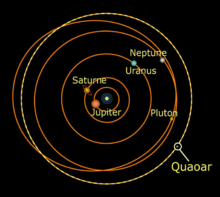(50000) quaoar
Quaoar is a minor body in the solar system, number 50000 in the series and provisionally designated 2002 LM60. It was discovered from Palomar Mountain/NEAT on June 4, 2002 with the Schmidt 1.2-meter telescope + CCD by Chadwick A. Trujillo and Michael E. Brown. Charles T. Kowal had observed it on June 17 and 18. May 1983, without acknowledging it. It has a single satellite, called Weywot.
It had also been sighted at various times at the Siding Spring and Haleakala-NEAT/MSSS observatories. With all these observations and astrometric measurements, they have made it possible to calculate an orbit that is sufficiently precise for it to have been assigned a definitive number and named with the name with which its discoverers have baptized it. The name "Quaoar" It originates from the name of the force of creation worshiped by the Tongva tribe, the original settlers of the region where Los Angeles is located today, near Pasadena, where the headquarters of the California Institute of Technology is located.
It has a diameter of 1,100 km and an area of 3,801,327 km², comparable to Charon (Pluto's satellite), and is also about half the diameter of Pluto itself (2,300 km in equatorial diameter). It belongs to the Kuiper belt.
Quaoar is orbiting at a distance just slightly greater than the most distant planet in the solar system. Quaoar moves relative to background stars in the discovery images, taken by the Oschin Telescope in Palomar, California.
Signs of water ice have been found, suggesting that cryovolcanism may be occurring. A small amount of methane is present on Quaoar's surface, which can only be held by the largest Kuiper belt objects.
Classification
Knowing that Quaoar is a binary object, its mass can be calculated by analyzing the orbit of the secondary object. Quaoar's density is estimated to be around 4.2 g/cm³, and estimates suggest that objects 890 km or larger in diameter should qualify as a dwarf planet if the mass required for hydrostatic equilibrium is sufficient. Mike Brown estimates that rocky bodies of about 900 km in diameter relax in hydrostatic equilibrium, and that ice bodies do so from about 400 km. With an estimated mass greater than 1.3×1021 kg, Quaoar most likely has the required mass of 5×1020 kg to be considered a dwarf planet under the 2006 redefinition of a planet, and Brown states that Quaoar "must be" a dwarf planet. Analysis of the light amplitude curvature shows only small deviations, suggesting that Quaoar is in fact a spheroid, with small albedo spots, and therefore a dwarf planet.
Satellite
Weywot, officially named (50000) Quaoar I Weywot, is the only known satellite of Quaoar. It was discovered on February 22, 2007, based on precovery images obtained on February 14, 2006. It is estimated to have a diameter of 74 km. It is possible that Weywot is a fragment of Quaoar originating from a collision.
Contenido relacionado
Capricorn (Constellation)
Equinox precession
William McCool

